Welcome to Admalite, your trusted source for chain hoist installation services and related products. Installing a chain hoist can be a daunting task, but it’s an essential part of many industrial, commercial, and residential applications. Whether you need to lift heavy loads in your garage or warehouse, or you need a reliable lifting solution for your business, a properly installed chain hoist can make all the difference. In this article, we will explore the importance of chain hoist installation and provide you with essential information on how to install a chain hoist correctly. We will also answer common questions about chain hoist installation and provide you with tips on how to ensure safe and efficient operation. Let’s get started!
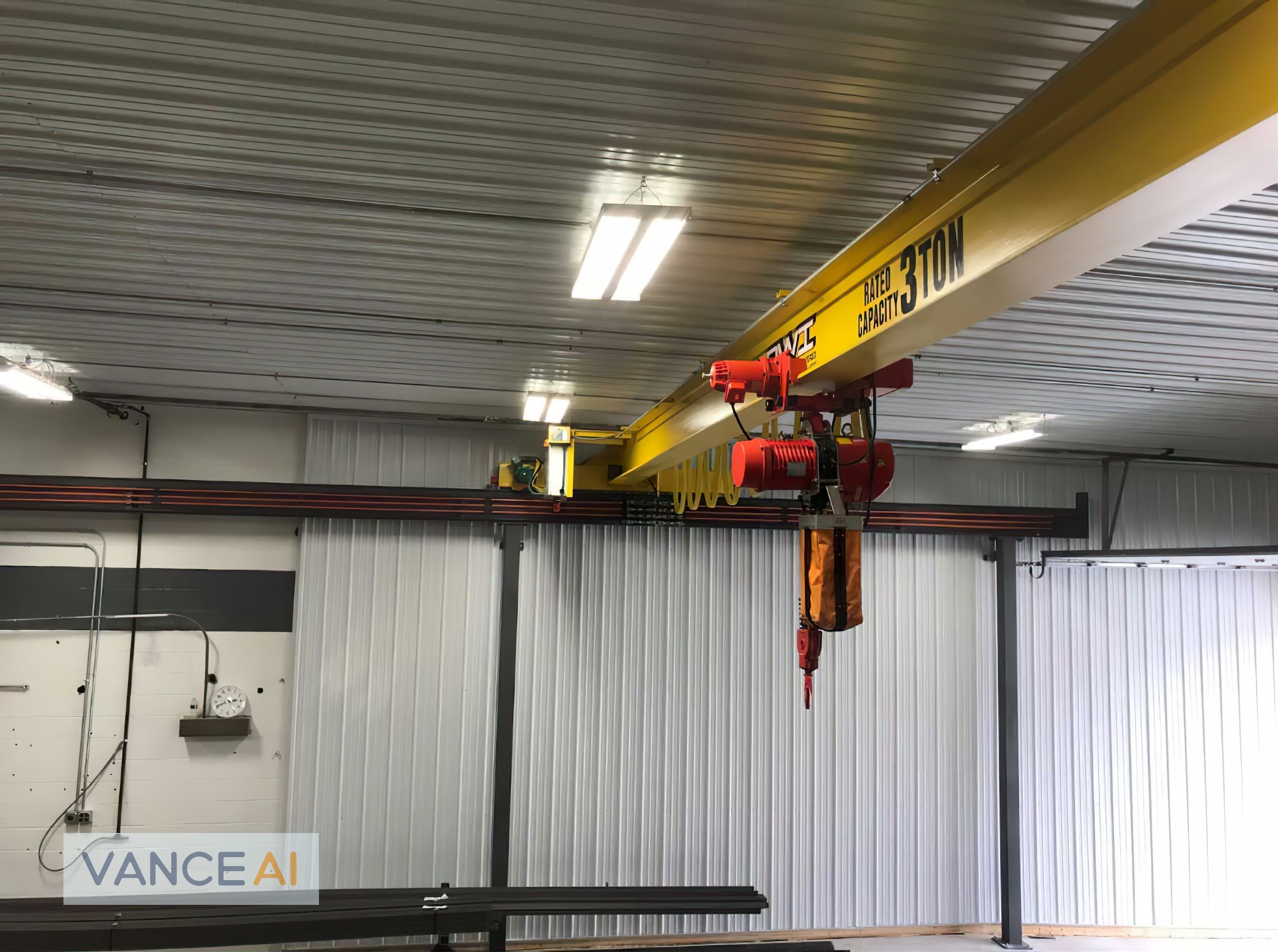
How to Install a Chain Hoist
Proper installation of chain hoists plays a critical role in ensuring safe and efficient lifting operations. Whether it’s in a warehouse, manufacturing facility, or construction site, chain hoists are indispensable tools that enable the lifting and movement of heavy loads with ease. However, the benefits of chain hoists can only be fully realized when they are installed correctly. From enhancing safety to optimizing productivity, proper chain hoist installation is essential in every lifting application.
Chain hoists serve as reliable mechanical devices designed to handle various lifting tasks. They are equipped with robust chains and hooks capable of supporting substantial weight loads. With their versatility and ability to handle both small and large loads, chain hoists have become indispensable tools across a wide range of industries. From lifting heavy equipment during construction projects to streamlining warehouse operations, chain hoists significantly contribute to improving efficiency and reducing manual labor.
While the capabilities of chain hoists are unquestionable, their effectiveness largely depends on proper installation. An incorrectly installed chain hoist can compromise safety, damage the load being lifted, or even lead to accidents that put personnel at risk. By understanding the importance of proper installation techniques and following industry best practices, businesses can maximize the benefits of their chain hoists and ensure smooth and secure lifting operations.
In the following sections, we will delve into the crucial aspects of chain hoist installation, providing valuable insights and practical tips to guide you through the process. From determining the installation environment to conducting load tests, we will cover each step in detail, enabling you to install your chain hoists with confidence and reap the full benefits they offer. So, let’s dive into the world of chain hoist installation and discover the key factors that contribute to their safe and efficient operation.
If you need to install a chain hoist, it’s essential to do it correctly to ensure safe and efficient operation. Here is a step-by-step guide on how to install a chain hoist:
- Determining the Installation Environment
- Choosing the Mounting Type
- Checking the Structure and Load Capacity
- Installing the Chain Hoist
- Electrical Connection
- Chain Alignment and Load Testing
- Full Load Testing and Compliance
At Admalite, we have years of experience in chain hoist installation and can help you choose the right hoist for your needs and install it correctly. Whether you need a manual or an electric chain hoist, we have the expertise to get the job done right. Contact us today to learn more about our chain hoist installation services.
Determining the Installation Environment:
Before embarking on the installation of a chain hoist, it is crucial to thoroughly assess the installation environment. The surrounding conditions and factors within the environment can significantly impact the performance and longevity of the chain hoist. By understanding and considering these factors, you can make informed decisions and ensure the hoist is installed in an optimal location.
Assessing the installation environment serves several purposes. Firstly, it helps identify potential hazards or challenges that may affect the safe and efficient operation of the chain hoist. Secondly, it allows for the selection of the most suitable type of chain hoist based on the specific environmental conditions. Lastly, it enables the implementation of necessary measures to protect the hoist from potential damage or premature wear.
There are various factors to consider when assessing the installation environment for a chain hoist. One important factor is temperature. Extreme temperatures, whether excessively hot or cold, can affect the performance of the hoist and its components. High temperatures can cause accelerated wear and reduce the hoist’s load-bearing capacity, while freezing temperatures can impact lubrication and cause mechanical issues. It is essential to ensure that the installation environment falls within the recommended temperature range specified by the manufacturer.
Humidity is another critical factor to consider. Excessive humidity levels can lead to corrosion and rust, particularly in the hoist’s chains, hooks, and other metallic components. This can compromise the structural integrity and safety of the hoist. If the installation environment is prone to high humidity, it is advisable to select a chain hoist with corrosion-resistant materials or implement measures to mitigate the effects of moisture.
Additionally, it is essential to identify and address the presence of hazardous substances or conditions in the installation environment. Chemicals, dust, fumes, or other airborne contaminants can adversely affect the performance of the chain hoist and pose risks to personnel. In such cases, appropriate safety measures, such as protective coatings or enclosures, should be considered to safeguard the hoist and ensure the well-being of workers.
By thoroughly assessing the installation environment and considering factors such as temperature, humidity, and hazardous substances, you can make informed decisions regarding the selection, positioning, and protection of the chain hoist. Admalite understands the importance of a suitable installation environment and offers a range of chain hoists designed to withstand various environmental conditions. Ensure that you create an environment conducive to the safe and efficient operation of the chain hoist, promoting productivity while maintaining the longevity of the equipment.
Choosing the Mounting Type:
When it comes to installing a chain hoist, one of the key decisions to make is selecting the appropriate mounting type. The mounting type determines how the chain hoist will be positioned and operated within your workspace. There are two primary options to consider: fixed installation and trolley-mounted hoists. Each option has its advantages and considerations, and understanding them will help you make an informed choice based on your specific lifting needs and workspace requirements.
- Fixed Installation:
Fixed installation involves securing the chain hoist to a permanent structure, such as a ceiling beam or overhead support. This type of installation is ideal when you have a dedicated lifting area and a consistent need for vertical lifting within that space. Some considerations for selecting a fixed installation include:- Stability: Ensure that the structure to which the chain hoist will be attached is stable, strong, and capable of supporting the weight capacity of the hoist and the loads it will handle.
- Height: Consider the height of the fixed installation, taking into account the maximum lift height required for your application. Measure the available space from the hoist’s mounting point to the floor to ensure it meets the lifting requirements without any obstructions.
- Accessibility: Evaluate how easily personnel can access the fixed installation. It should allow for safe and convenient operation, including attaching and detaching loads.
- Flexibility: Keep in mind that a fixed installation limits the mobility of the chain hoist. If you require the ability to move the hoist between different work areas, a trolley-mounted hoist may be a more suitable choice.
- Trolley-Mounted Hoists:
Trolley-mounted hoists feature a trolley mechanism that allows the hoist to move horizontally along a beam or track. This type of installation offers greater flexibility and versatility, making it suitable for applications that require horizontal movement or lifting in different areas. Consider the following factors when selecting a trolley-mounted hoist:- Beam or Track Selection: Choose a suitable beam or track system based on the weight capacity of the hoist and the loads it will handle. Ensure that the beam or track is securely mounted and capable of supporting the hoist’s movement.
- Track Configuration: Determine whether a straight track or a curved track is required based on the layout of your workspace. Curved tracks are beneficial for navigating corners or obstacles.
- Clearance: Measure the available clearance height to ensure that the trolley-mounted hoist can move freely without any obstructions.
- Trolley Type: Select the appropriate trolley type, such as manual push trolleys or motorized trolleys, depending on your specific requirements and workload.
By considering factors such as stability, height, accessibility, flexibility, beam or track selection, track configuration, clearance, and trolley type, you can determine the most suitable mounting type for your chain hoist installation. Admalite offers a range of chain hoists compatible with both fixed and trolley-mounted installations, ensuring that you have the flexibility to choose the option that best suits your lifting needs and workspace constraints.
Checking the Structure and Load Capacity:
Before installing a chain hoist, it is crucial to thoroughly inspect the strength and integrity of the structure to which the hoist will be mounted. The structure’s ability to withstand the weight and stress imposed by the hoist and the loads it will lift is paramount to ensure safe and efficient operations. Additionally, determining the load capacity is essential to match it with the capabilities of the chain hoist. Let’s explore these two aspects in more detail:
- Inspecting the Structure’s Strength:
Inspecting the structure is a critical step in ensuring the safety and stability of the chain hoist installation. Here are some important considerations:- Visual Examination: Conduct a thorough visual inspection of the mounting point, whether it’s a ceiling beam, support structure, or overhead crane. Look for any signs of damage, corrosion, cracks, or structural weaknesses that could compromise the integrity of the installation.
- Load-Bearing Capacity: Determine the load-bearing capacity of the structure and ensure it is sufficient to support the weight of the hoist, the loads it will lift, and any additional safety factors. Consult the structural engineer or review the specifications provided by the structure manufacturer to ensure compliance.
- Reinforcement: If necessary, reinforce the structure to enhance its load-bearing capacity. This may involve strengthening the support beams, adding additional bracing, or consulting with a professional engineer to ensure proper reinforcement techniques are employed.
- Determining the Load Capacity:
Determining the load capacity is crucial to ensure that the chain hoist can safely handle the anticipated loads. Here’s how to go about it:- Consult Manufacturer Specifications: Refer to the manufacturer’s specifications for the chain hoist to determine its rated load capacity. It is essential to strictly adhere to these guidelines to prevent overloading the hoist.
- Consider the Application Requirements: Assess the maximum weight of the loads you intend to lift and ensure that the chain hoist’s capacity exceeds or matches these requirements. It is advisable to factor in additional safety margins to account for unexpected variations or dynamic loads.
- Safety Factors: Take into account any safety factors recommended by the manufacturer or industry standards. These factors account for potential variations, contingencies, or safety margins to ensure the hoist operates within a safe working range.
By thoroughly inspecting the structure’s strength and determining the load capacity, you can ensure that the chain hoist is appropriately matched to the installation environment. This meticulous evaluation guarantees the safety and reliability of the chain hoist during lifting operations. Admalite understands the importance of proper load capacity assessment and offers a range of chain hoists with various load capacities to suit different lifting requirements. Prioritizing the structural integrity and load capacity ensures optimal performance and longevity of the chain hoist, giving you confidence in its safe and efficient operation.
Installing the Chain Hoist:
Once you have assessed the installation environment, determined the mounting type, and checked the structure’s strength and load capacity, it’s time to proceed with the actual installation of the chain hoist. The installation process will vary depending on whether you have chosen a fixed installation or a trolley-mounted hoist. Here are step-by-step instructions for each type:
Fixed Installation:
- Gather the necessary equipment and tools: Before starting the installation, ensure that you have all the required equipment and tools, including the chain hoist, mounting brackets, bolts, nuts, washers, and appropriate wrenches.
- Position the hoist: Position the chain hoist directly beneath the mounting point on the structure. Make sure that it is aligned with the desired lifting area and that there is sufficient clearance for the hoist to operate smoothly.
- Attach the mounting brackets: Depending on the design of the hoist and the mounting point, use the provided mounting brackets and secure them to the structure using the appropriate hardware. Ensure that the brackets are securely attached and properly aligned.
- Install the chain hoist: With the mounting brackets in place, carefully attach the chain hoist to the brackets, ensuring a secure fit. Follow the manufacturer’s instructions for attaching the hoist to the brackets and double-check that all connections are properly tightened.
- Verify alignment and secure attachment: Once the hoist is installed, visually inspect the alignment of the hoist and ensure that it is level. Check that all bolts and fasteners are securely tightened to prevent any potential movement or loosening during operation.
Trolley-Mounted Hoists:
- Assemble the trolley: If your chain hoist is trolley-mounted, begin by assembling the trolley mechanism according to the manufacturer’s instructions. Ensure that all components are properly connected and securely tightened.
- Position the beam or track: Install the beam or track system along the desired path for the trolley-mounted hoist. Ensure that it is securely mounted and capable of supporting the weight of the hoist and the loads it will handle.
- Attach the trolley to the beam or track: Mount the trolley on the beam or track system, ensuring that it moves smoothly and without any obstructions. Secure the trolley to the beam or track using the provided hardware, following the manufacturer’s guidelines.
- Install the chain hoist on the trolley: With the trolley in place, carefully attach the chain hoist to the trolley mechanism, ensuring a secure connection. Follow the manufacturer’s instructions for attaching the hoist, including any additional brackets or attachments required.
- Verify alignment and secure attachment: Once the hoist is installed on the trolley, visually inspect the alignment of the hoist and ensure that it is level. Check that all bolts and fasteners are securely tightened to prevent any potential movement or loosening during operation.
Throughout the installation process, it is crucial to use the proper hardware and follow the manufacturer’s instructions. This includes using the recommended bolts, nuts, washers, and other attachments to ensure secure and safe attachment of the chain hoist. Admalite understands the significance of proper installation and provides reliable chain hoists accompanied by detailed installation instructions. By adhering to these guidelines and using the appropriate hardware, you can ensure the chain hoist is installed correctly, promoting safe and efficient lifting operations.
Electrical Connection:
When installing a chain hoist, the electrical connection plays a crucial role in its proper functioning and safety. It is essential to understand and adhere to the electrical aspects of the installation process. Here are key points to consider:
- Involvement of a Certified Electrician: Electrical connections should always be handled by a certified electrician or a qualified professional who has the necessary knowledge and experience in electrical installations. This ensures compliance with electrical codes and regulations, minimizing the risk of electrical hazards.
- Safety Measures: The electrical connection must include appropriate safety measures to protect against overcurrent and overvoltage situations. This helps safeguard the hoist, the operator, and the surrounding equipment. It is recommended to consult with an electrician to determine the specific safety devices required for your installation.
- Overcurrent Protection Devices: Overcurrent protection devices, such as circuit breakers or fuses, are essential in preventing excessive current flow that could damage the hoist or cause a safety hazard. These devices are designed to interrupt the electrical circuit when current exceeds a certain threshold, protecting the hoist and associated electrical components.
- Overvoltage Protection Devices: Overvoltage protection devices are crucial for preventing damage to the hoist from voltage spikes or fluctuations. These devices are designed to regulate and limit the voltage supplied to the hoist, ensuring its safe and reliable operation.
- Proper Cable Installation: Ensure that the electrical cables used for the hoist installation are suitable for the intended application and comply with electrical standards. Cables should be correctly sized, properly insulated, and securely installed to prevent damage, tripping hazards, or exposure to environmental factors.
- Festoon System: In some cases, a festoon system may be used to guide and protect the electrical cables along the hoist’s travel path. Proper installation of the festoon system is crucial to prevent cable entanglement or damage.
It is important to recognize that electrical connections are complex and require specialized knowledge. Involving a certified electrician ensures that the electrical aspects of the chain hoist installation are handled professionally and in accordance with electrical codes and regulations. Admalite recognizes the significance of electrical safety and recommends seeking professional assistance for the electrical connection of their chain hoists.
By following these electrical guidelines, you can ensure the safe and reliable operation of the chain hoist, reducing the risk of electrical issues and promoting a secure lifting environment.
Chain Alignment and Load Testing:
Ensuring proper chain alignment and conducting load testing are essential steps in the installation of a chain hoist. These measures contribute to the safe and efficient operation of the hoist system. Let’s explore their significance and the steps involved:
- Proper Chain Alignment:
Proper chain alignment is crucial for the smooth and reliable operation of the chain hoist. Misaligned chains can lead to increased friction, premature wear, and potential malfunctions. Here’s why chain alignment is important:- Reduced Wear: Proper alignment minimizes unnecessary strain and wear on the chain links, sprockets, and other components. It helps distribute the load evenly across the chain, maximizing its lifespan and performance.
- Smooth Operation: Well-aligned chains facilitate smooth and efficient movement of the hoist, ensuring precise lifting and lowering of loads. It reduces the chances of chain slippage, jerky movements, or uneven load distribution.
To achieve proper chain alignment, visually inspect the chain path and ensure that the chain runs smoothly along the sprockets without any twists, kinks, or interference. Adjust the chain tension if necessary, following the manufacturer’s guidelines.
- Empty Load Test:
Conducting an empty load test is an essential step to verify the functionality and performance of the chain hoist before using it for actual lifting operations. Here’s how to perform an empty load test:- Raise the Hook: Operate the chain hoist to raise the hook without any load attached. Observe the hoist’s movement, ensuring that it operates smoothly, without jerks, unusual noises, or signs of instability.
- Check Controls: Test the control buttons or switches to ensure they function correctly and respond appropriately. This includes the up and down movements, as well as any emergency stop or limit switch activation.
- Evaluate Safety Features: Verify that the upper and lower limit switches engage at the appropriate positions to prevent overtravel. This ensures that the hoist stops automatically when it reaches the desired upper or lower limits.
- Observe Chain Movement: Pay close attention to the chain’s movement during the empty load test. Look for any signs of chain slippage, binding, or abnormal behavior. If any issues are detected, address them promptly before proceeding with actual load lifting.
- Checking the Upper and Lower Limit Switches:
The upper and lower limit switches are critical safety features in a chain hoist. They prevent overtravel and provide an added layer of protection during lifting operations. Here’s why checking these switches is important:- Prevent Overtravel: The upper limit switch ensures that the hoist stops automatically when it reaches the maximum allowed height, preventing the risk of damage to the hoist or the structure. Similarly, the lower limit switch halts the hoist when it reaches the desired lower limit.
- Safety Assurance: Regularly checking and verifying the functionality of the limit switches is crucial to ensure their proper operation. This helps prevent accidents, damage, or unintended movements beyond the specified limits.
During the installation process, ensure that the upper and lower limit switches are correctly installed, properly adjusted, and in good working condition. Test their functionality by operating the hoist and observing if they engage at the intended positions.
By focusing on proper chain alignment, conducting an empty load test, and checking the upper and lower limit switches, you can ensure the safe and efficient operation of the chain hoist. Admalite understands the significance of these steps and provides guidance and support to ensure their customers’ chain hoists are properly aligned and tested before use. Prioritizing these measures contributes to a reliable and secure lifting environment.
Full Load Testing and Compliance:
Conducting a full load test and adhering to safety norms and standards are crucial aspects of chain hoist installation. These measures ensure the safe and reliable operation of the hoist system. Here’s a closer look at their significance:
- Full Load Testing:
Performing a full load test involves subjecting the chain hoist to its maximum rated capacity to validate its performance under actual working conditions. Here are the benefits of conducting a full load test:- Safety Verification: A full load test allows for a comprehensive assessment of the hoist’s capacity and performance. It ensures that the hoist can handle the intended workload without exceeding its limits, reducing the risk of accidents, equipment damage, or structural failures.
- Reliability Assurance: By testing the chain hoist under full load, you can evaluate its stability, smoothness of operation, and overall functionality. This helps identify any potential issues or malfunctions that may arise during real-world lifting tasks.
- Confidence in Performance: A successful full load test provides confidence in the hoist’s ability to handle the expected loads, enabling operators to carry out lifting operations with peace of mind.
It is important to note that full load testing should be conducted in accordance with the manufacturer’s guidelines and safety recommendations. Admalite recognizes the significance of this step and provides support and guidance to ensure their customers’ chain hoists are properly tested.
- Safety Norms and Standards:
Adhering to safety norms and standards is paramount when installing a chain hoist. These norms outline the requirements and best practices to ensure a safe working environment. Some key aspects to consider include:- Compliance: Ensure that the chain hoist installation complies with relevant safety norms and standards, such as those set by regulatory bodies or industry-specific guidelines. These standards may cover aspects such as load capacity, equipment design, electrical safety, and operator training.
- Inspections and Certifications: Regular inspections and certifications help verify that the chain hoist meets the required safety standards. Periodic assessments by certified inspectors ensure that the hoist remains in optimal condition and complies with safety regulations.
- Documentation: Maintain proper documentation of the installation process, inspections, and certifications. This documentation serves as evidence of compliance and can be essential for audits, safety assessments, or insurance purposes.
Adhering to safety norms and standards is crucial to promote a safe and secure working environment for both operators and the surrounding infrastructure.
- Operator Training:
Proper operator training is essential for safe and efficient chain hoist operation. Operators should receive comprehensive training on the specific model and type of hoist they will be using. Training should cover areas such as:- Hoist Functionality: Operators should be familiar with the hoist’s controls, operating procedures, and safety features. They should know how to perform pre-use inspections, recognize potential hazards, and respond to emergency situations.
- Load Handling Techniques: Operators should be trained in proper load attachment, rigging techniques, and load weight estimation. They should understand how to assess load stability, distribute the load evenly, and avoid overloading the hoist.
- Safety Protocols: Operator training should include safety protocols specific to the chain hoist, such as the use of personal protective equipment, safe working distances, and communication practices during lifting operations.
By investing in proper operator training, employers can enhance workplace safety, prevent accidents, and ensure efficient and effective use of the chain hoist.
In conclusion, conducting a full load test, adhering to safety norms and standards, and providing proper operator training are essential aspects of chain hoist installation. Admalite understands the importance of these measures and encourages their customers to follow best practices to ensure the safe and compliant operation of their chain hoists. Prioritizing full load testing and compliance not only ensures the safety of personnel and equipment but also helps maintain a reliable and efficient lifting operation.
By conducting a full load test, you can verify the chain hoist’s performance under realistic working conditions, ensuring that it can handle the intended workload without compromising safety. It allows for the identification of any potential issues or limitations before actual lifting tasks are performed.
Additionally, adherence to safety norms and standards is crucial for a safe working environment. Compliance with regulations and industry-specific guidelines ensures that the chain hoist installation meets recognized safety requirements. This includes aspects such as load capacity, equipment design, electrical safety, and operator training. By following these standards, you can minimize risks, prevent accidents, and promote a culture of safety within your organization.
Proper operator training is another essential element in chain hoist installation. Operators should receive comprehensive training that covers the specific model and type of hoist they will be using. Training should include familiarizing operators with the hoist’s controls, operating procedures, and safety features. It should also focus on load handling techniques, including proper attachment, rigging, and load estimation. By providing operators with the necessary knowledge and skills, you empower them to operate the chain hoist safely and efficiently.
Admalite recognizes the importance of full load testing, compliance with safety norms, and operator training. As a trusted provider of chain hoist installation services, Admalite ensures that their customers’ installations undergo thorough testing, meet safety requirements, and are operated by trained personnel. By partnering with Admalite, you can have confidence in the performance and safety of your chain hoist system.
In conclusion, prioritizing full load testing, compliance with safety norms and standards, and operator training is essential for successful chain hoist installation. Admalite’s commitment to these principles ensures that their customers receive reliable, compliant, and safe chain hoist installations. Contact Admalite today to benefit from their expertise and comprehensive range of chain hoist installation services.
Conclusion:
Proper chain hoist installation is essential for ensuring safe and efficient lifting operations. By following the necessary steps and adhering to safety protocols, you can minimize risks, protect personnel and equipment, and maintain a productive work environment. Here’s a recap of the key points covered in this article:
- Determine the installation environment: Assess factors such as temperature, humidity, and hazardous substances to ensure the suitability of the installation location.
- Choose the mounting type: Consider whether a fixed installation or a trolley-mounted hoist is more suitable for your specific requirements.
- Check the structure and load capacity: Verify that the installation structure is robust enough to support the load capacity of the hoist and comply with safety standards.
- Install the chain hoist: Follow the recommended steps for installation, ensuring the use of proper hardware and secure attachment.
- Handle electrical connections: Involve a certified electrician to handle the electrical aspects of the installation, including overcurrent and overvoltage protection devices.
- Align the chain and conduct load testing: Ensure proper chain alignment, conduct empty and full load tests, and check the upper and lower limit switches to validate the hoist’s performance.
- Comply with safety norms and standards: Adhere to safety regulations and industry-specific guidelines to maintain a safe working environment.
- Provide operator training: Ensure operators are properly trained in hoist functionality, load handling techniques, and safety protocols.
Admalite, a trusted provider of chain hoist installation services, understands the importance of these steps and offers expertise and support throughout the installation process. With their comprehensive range of products and services, Admalite ensures that your chain hoist installation meets the highest standards of safety and performance.
In conclusion, prioritize safety and consult experts like Admalite for your chain hoist installation needs. By following proper installation procedures, adhering to safety guidelines, and investing in operator training, you can create a safe and efficient lifting environment. Trust Admalite to be your partner in achieving optimal chain hoist installations. Contact them today to benefit from their expertise and support.
Types of Chain Hoists
Chain hoists come in different types, each with its unique features and applications. Understanding the differences between the three main types of chain hoists – manual, electric, and pneumatic – can help you choose the right one for your needs. In this section, we’ll explain the differences between each type and their uses, as well as highlight Admalite’s products and services related to each type.
Manual Chain Hoists
Manual chain hoists, also known as chain blocks, are the most common type of chain hoist. They are powered by hand and rely on the operator’s physical force to lift and lower the load. Manual chain hoists are compact, easy to use, and ideal for lifting loads in small spaces or where no power source is available. They are commonly used in garages, workshops, and small manufacturing facilities.
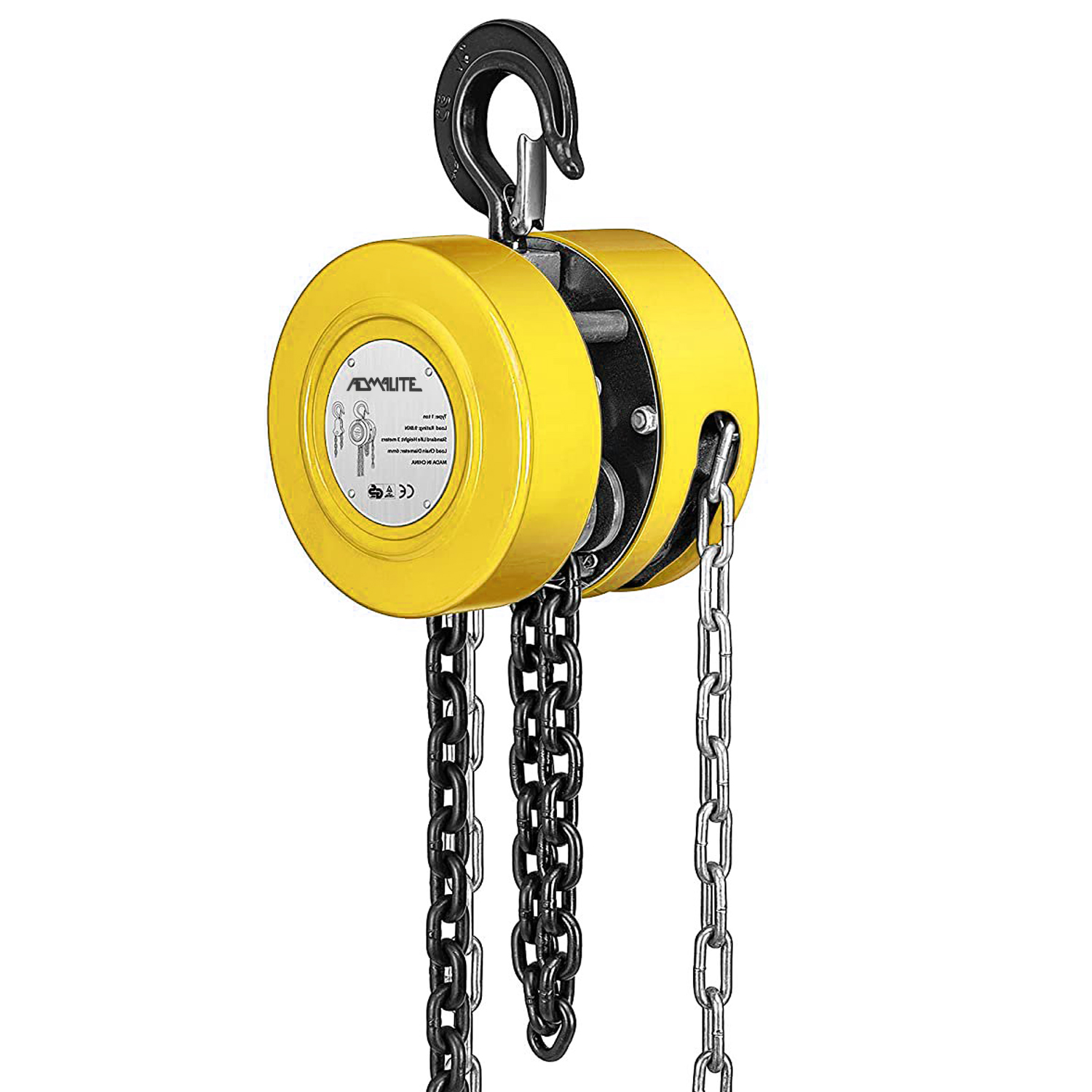
Electric Chain Hoists
Electric chain hoists are powered by electricity and are designed for heavier loads than manual chain hoists. They are more efficient and faster than manual chain hoists and are suitable for lifting and lowering loads in larger spaces. Electric chain hoists are often used in construction sites, warehouses, and industrial facilities. Admalite offers electric chain hoists from top brands, and we can help you with the chain block installation and how to install an electric chain hoist.
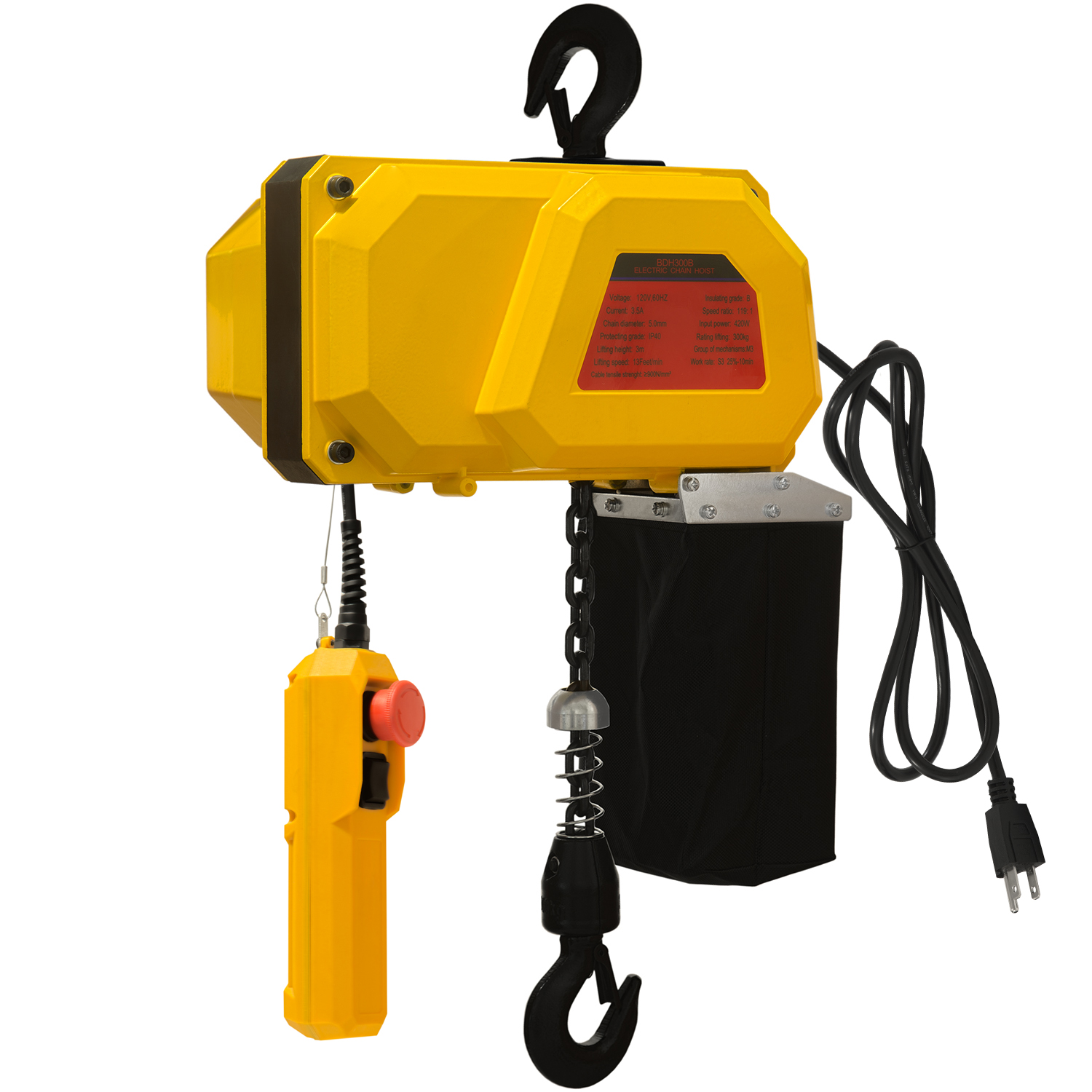
Pneumatic Chain Hoists
Pneumatic chain hoists, also known as air hoists, are powered by compressed air and are suitable for hazardous environments where electric hoists are not safe to use. They are commonly used in the oil and gas industry, mines, and chemical plants. Pneumatic chain hoists are also ideal for lifting and lowering loads in wet or humid environments where electricity is not recommended.

In summary, choosing the right chain hoist depends on your specific needs and applications. Admalite offers a wide range of chain hoists, including manual, electric, and pneumatic hoists, as well as related products and services, such as chain block installation and electric chain hoist installation. Contact us today to learn more about our products and services.
Chain Hoist Capacity and Security
When selecting a chain hoist, it’s crucial to consider the weight of the load you’ll be lifting. Choosing the wrong chain hoist size can be dangerous and cause accidents. To determine the correct chain hoist size, you need to know the weight of the load, the distance the load will be lifted, and the type of chain hoist you plan to use. Admalite chain hoist experts can help you select the right size chain hoist based on your specific needs.
Once you have the right chain hoist size, it’s important to secure the chain hoist for safe operation. A chain hoist that is not properly secured can cause serious injuries or damages. Always ensure that the hoist is securely mounted to a solid structure that can support the load’s weight. Make sure that the chain hoist’s hook is attached to the load correctly and that the load is evenly distributed.
At Admalite, we understand the importance of chain hoist capacity and security. That’s why we offer a wide range of chain hoists that come in various weight capacities and types, from manual chain hoists to electric and pneumatic chain hoists. We also provide installation services to ensure that your chain hoist is mounted safely and securely. Our experts can advise you on the right type and size of chain hoist to use for your particular lifting needs, as well as provide guidance on chain hoist security.
In summary, when it comes to chain hoist capacity and security, it’s essential to choose the right size chain hoist and to mount and secure it correctly. Admalite is your trusted source for quality chain hoists and expert installation services, so contact us today to learn more about our products and services, including chain hoist security.
Common Questions about Chain Hoist Installation
When it comes to chain hoist installation, there are many questions that customers ask. Below are some common questions and answers that can help you understand more about chain hoist installation and Admalite’s products and services:
A hoist is used to lift and move heavy loads vertically, while a winch is used to pull loads horizontally. Admalite offers both hoists and winches to suit different lifting and pulling needs.
The height of the garage needed for a hoist depends on the type and size of the hoist and the height of the load to be lifted. Admalite experts can advise you on the appropriate garage height needed for your specific lifting needs.
A hoist is a device used to lift and move heavy loads, while a lift is a platform used to raise and lower people or objects. Admalite offers a variety of hoists and lifts to suit different lifting needs.
The most efficient type of chain hoist depends on the specific lifting needs and the environment in which it will be used. Admalite offers manual, electric, and pneumatic chain hoists, each with its own advantages and efficiencies.
Like any equipment, a chain hoist can fail if not used properly or maintained regularly. Admalite provides maintenance and repair services to keep your chain hoist in good working condition.
The weight capacity of a chain hoist depends on the type and size of the hoist. Admalite offers a wide range of chain hoists with varying weight capacities to suit your lifting needs.
A hoist should be attached to a solid structure that can support the weight of the load. This can include a ceiling beam, a support frame, or a gantry crane. Admalite offers installation services to ensure that the hoist is mounted securely to the appropriate structure.
At Admalite, we understand the importance of providing clear and concise answers to your chain hoist installation questions. Contact us today to learn more about our products and services, including our expert installation services and maintenance and repair options.
Conclusion
In summary, proper chain hoist installation is essential to ensure safe and efficient operation. Admalite is a trusted provider of chain hoist installation services and related products. Whether you need a manual, electric, or pneumatic chain hoist, Admalite has the expertise and products to meet your needs. Remember to properly determine the chain hoist size and secure it for safe use. If you have any questions or need assistance with chain hoist installation, don’t hesitate to contact Admalite. Trust us for your chain hoist installation services and related products.
OTHER SERVICES
ADMALITE provides a range of services, including installation, maintenance, repair, load testing, customization, upgrades, consultation, replacement parts, and emergency callouts, ensuring their customers’ equipment operates safely and efficiently.
QUALITY GUARANTEE
UL Certification is a globally recognized standard for safety and quality assurance. UL Certification ensures that products and systems meet stringent safety requirements and comply with industry standards.
In the case of ADMALITE, their compliance with UL508A standards for industrial control panels ensures that their products are safe, reliable, and comply with industry standards, giving their customers peace of mind and confidence in the quality of their products.
FREE QUOTE
Do you need help finding out the right hoist? Fill out this form to get in touch.

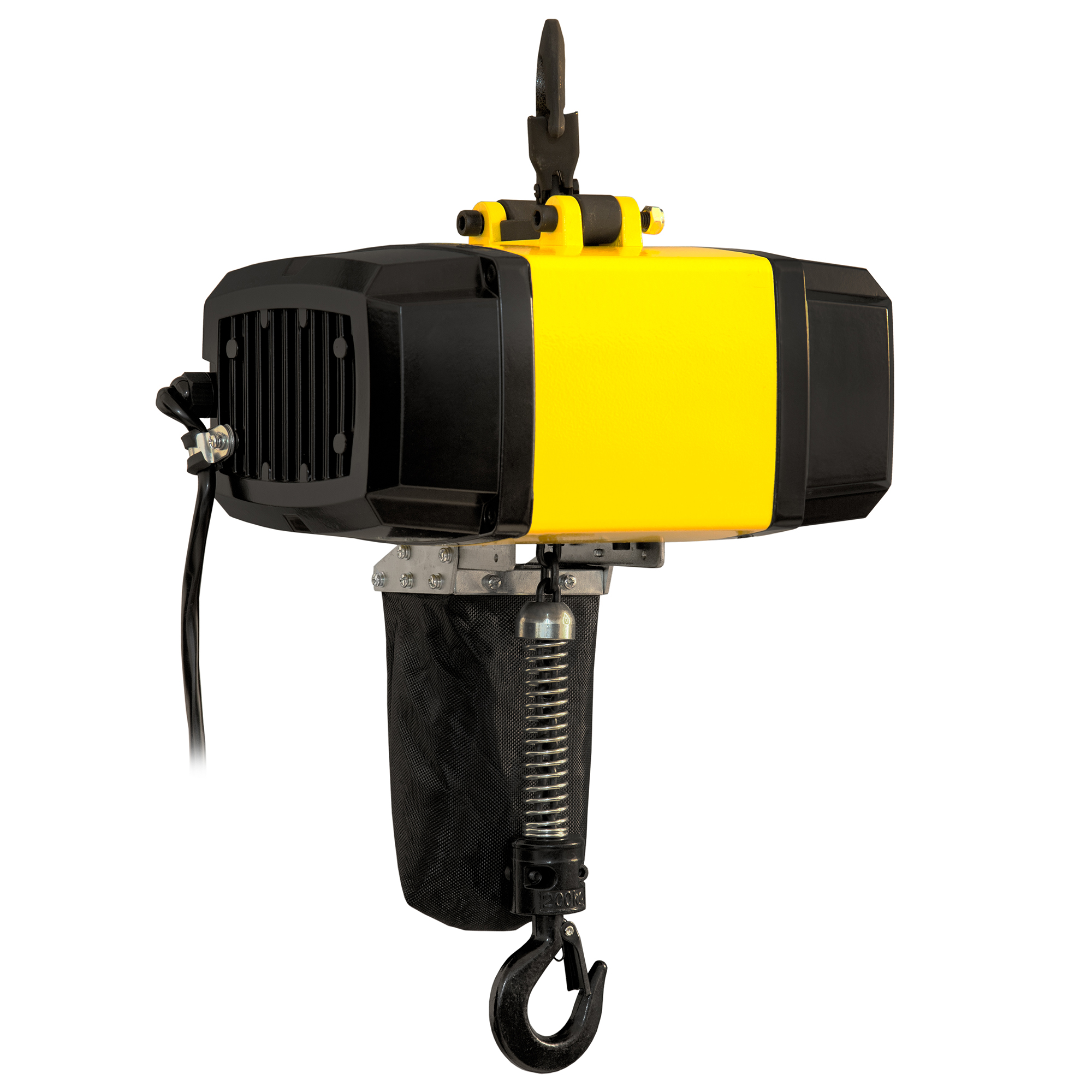
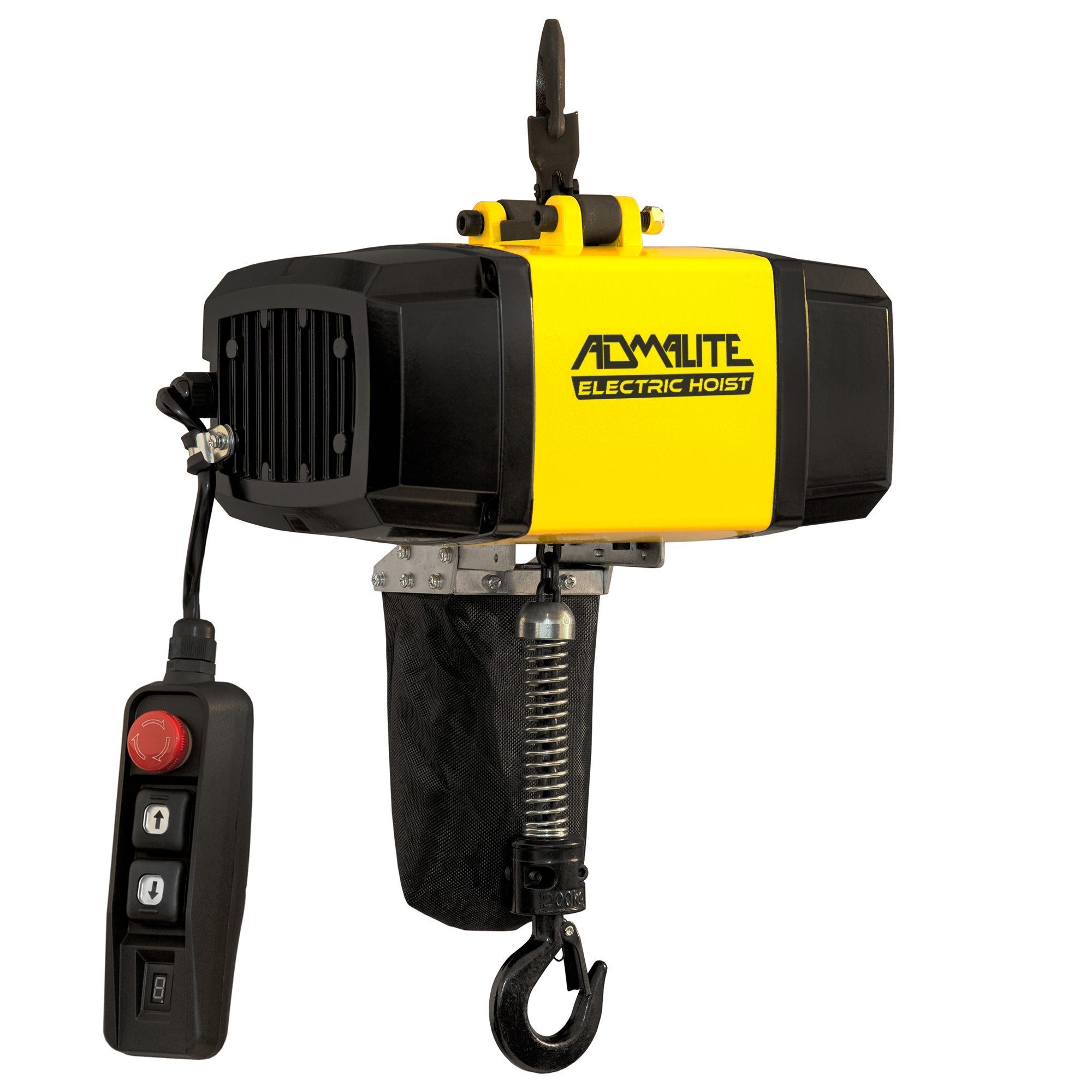
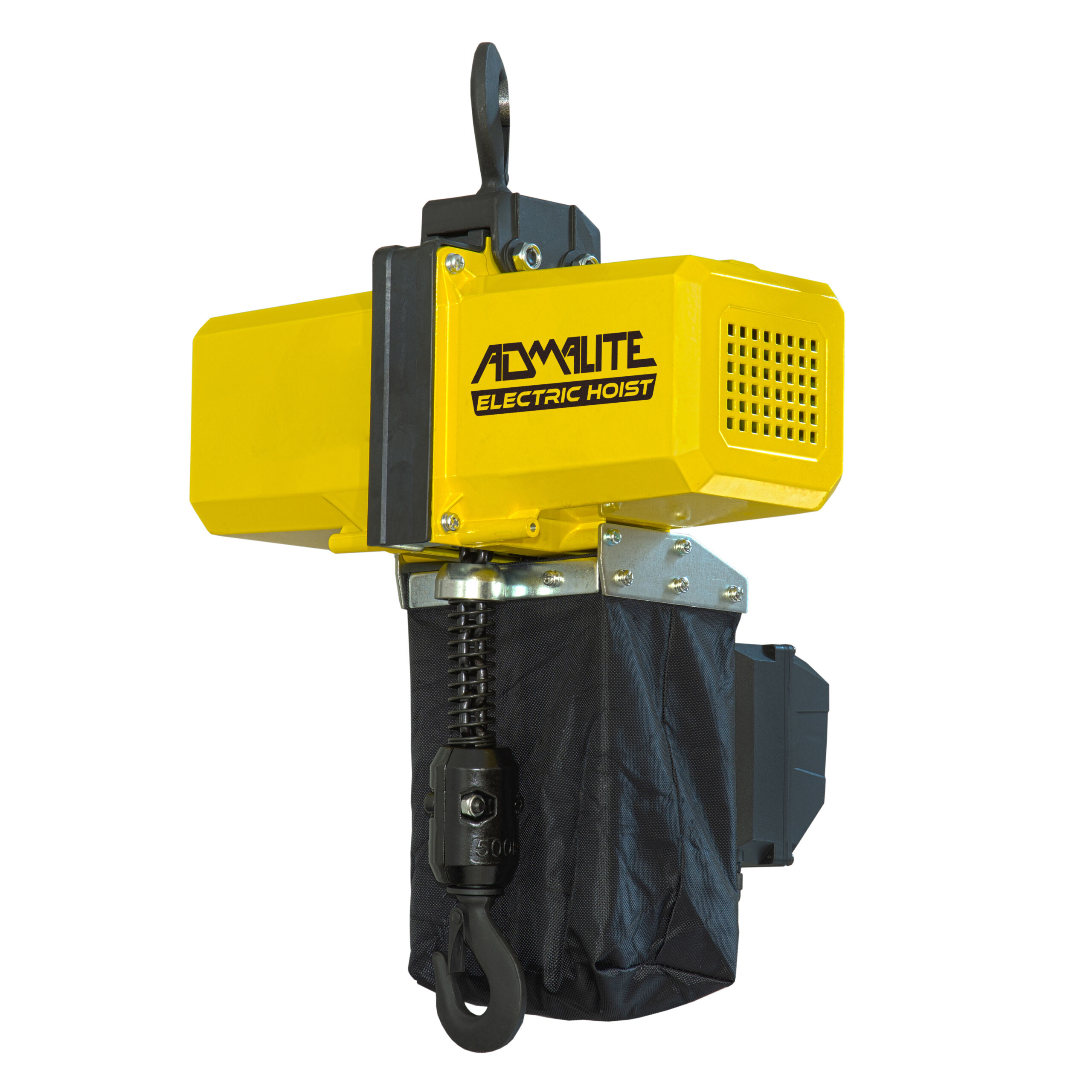


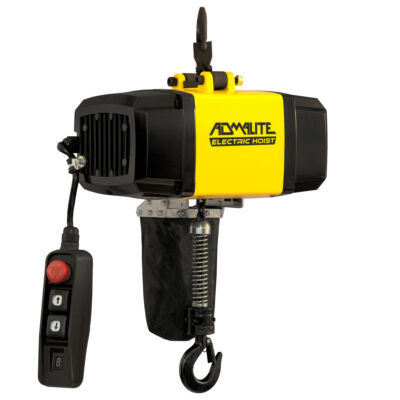 1100lb. Portable Mini Electric Chain Hoist - Variable Speed
1100lb. Portable Mini Electric Chain Hoist - Variable Speed